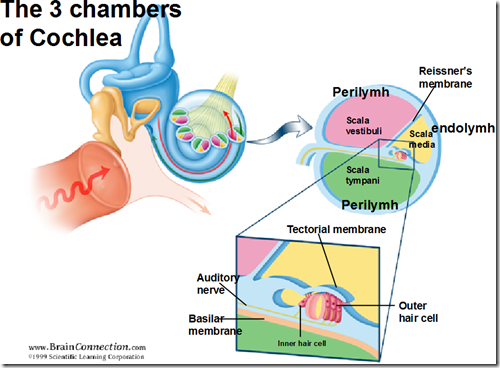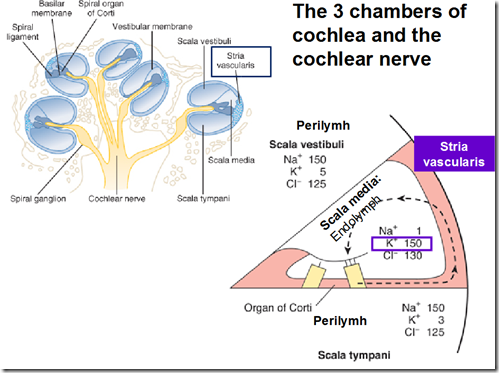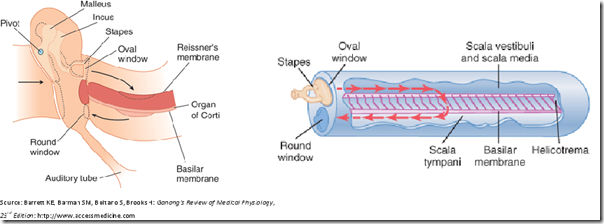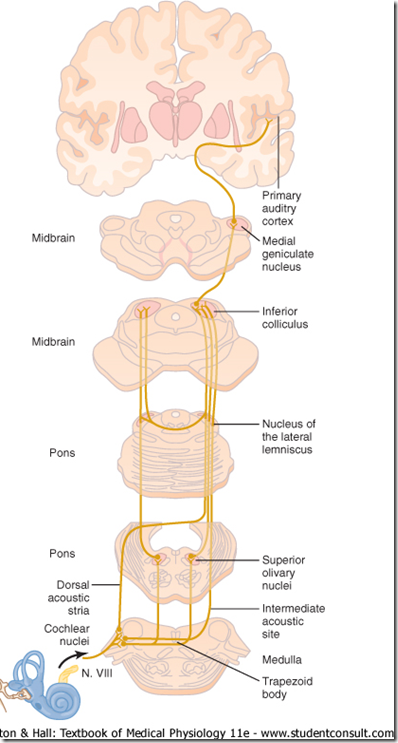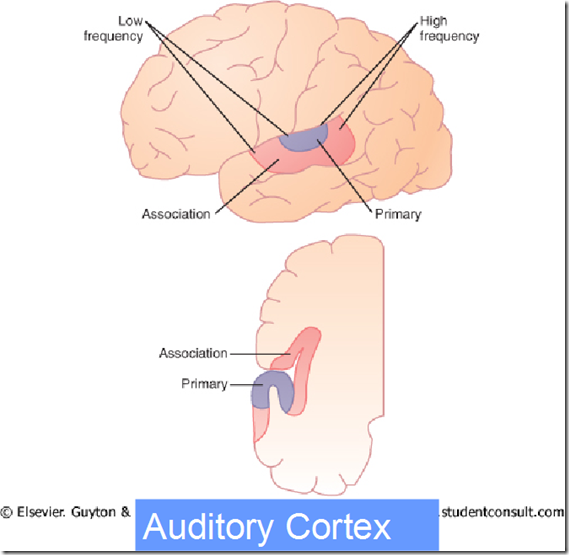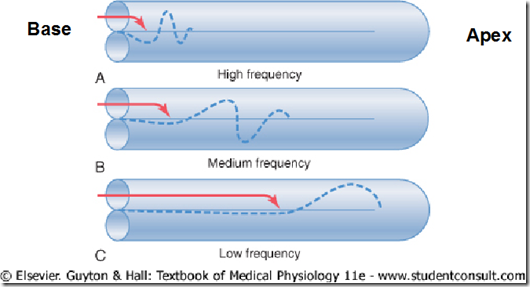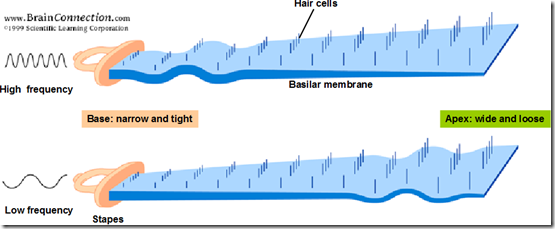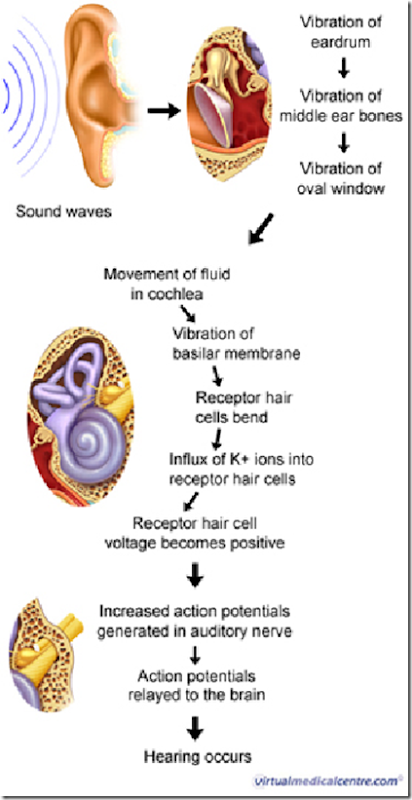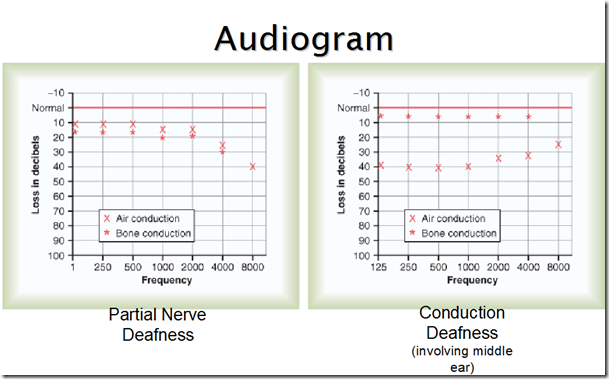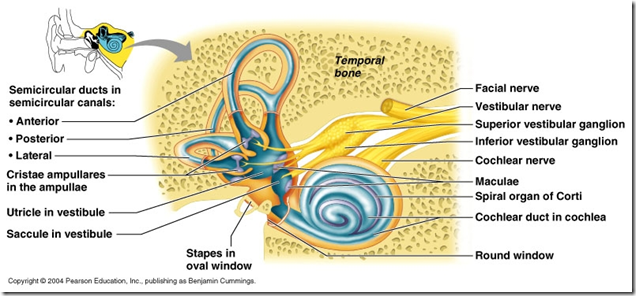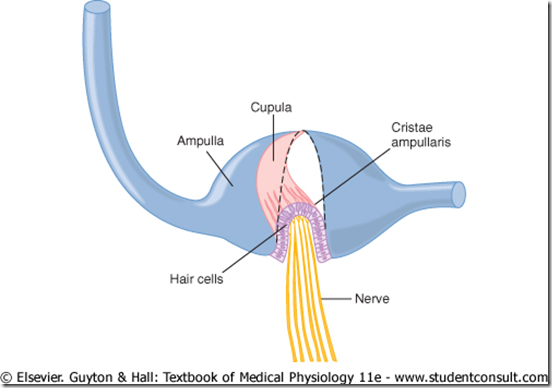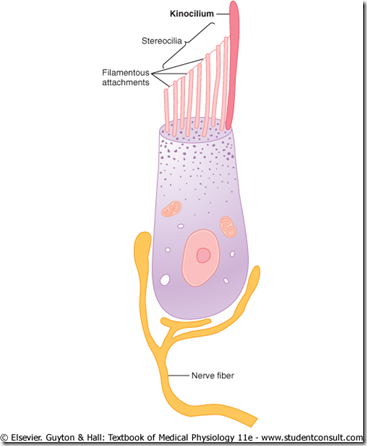*Read foundation 1 notes.
Hearing:
- Organ of hearing
- organ of Corti
- Sensory receptor
- cochlea duct
- nerve
- cochlear nerve
Equilibrium:
- Dancing with music
- dynamic equilibrium
- Organ of equilibrium
- dynamic: crista ampularis (hair cells + cupula) of the semicircular canals
- vestibular nerve
- static: maculae
Common characteristics – receptor for hearing & equilibrium
- Hair cells bathed in endolymph
- Hairs (cilia) of the cells are embedded in a dense mass
- Movement of the mass of hair cells relative to one another stretches/bends the cilia
- Stretching/ bending of cilia in 1 direction increases impulse generation
_____________________________________________________________________
Hearing (Audition)
Outline of hearing (3 major steps)
- Airborne sound consists of vibrations
- alternate phases of condensation & rarefaction
- the auditory apparatus convert these vibrations in air to vibrations in the inner ear fluid
- Vibrations lead to bending of cilia of hair cells (of the Organ of Corti)
- Generate nerve impulse
- transmit along auditory nerve to higher centers of hearing
Sound

- pressure wave produced by air by a vibrating body
- results from the back & forth vibration of the particles of the medium (air)
- resulting in alternate phases of condensations (compressions) and rarefactions
- Properties
- Greater amplitude (intensity of sound wave)
- louder the sound
- expressed as decibel (dB)
- 1 dB = 0.1 bel
- 1 bel
- the logarithm of the ratio of the intensity of the sound and a standard sound
- 0 dB
- not absence of sound
- sound level of an intensity equal to that of the standard
- threshold pressure
- 140 dB
- potentially damaging to auditory receptor
- organ of Corti
- Greater frequency
- higher the pitch
- Soundwaves that have repeating patterns
- perceived as musical sounds
- Aperiodic nonrepeating vibrations
- noisiness
Threshold for human hearing
- Threshold varies with the pitch of sound
- Greatest sensitivity range
- 1000-4000 Hz
- Audible frequency range
- 20 – 20,000 Hz
Hearing mechanism
- Collection & concentration of sound waves
- by ear lobes (pinna)
- Vibration of tympanic membrane
- in harmony with the frequency of sound source
- Movements of 3 ossicles
- In & out movement of the footplate of stapes at the oval window of cochlea
- pressing on the fluid in the cochlear
Impedance matching – function of the middle ear
- Auditory receptors of the inner ear
- operate in a fluid environment
- underwater sound receiver
- Effective transfer of sound energy from air (lower acoustic resistance/impedance) to fluid (higher acoustic resistance/impedance)
- is due to amplification of the pressure by:
- large ratio btwn the areas of tympanic membrane & stapes footplate-oval window (17:1)
- amplified 17 times
- pressure = force/area
- mechanical advantage of the ossicular lever system
- 1:3
3 chambers of cochlea & cochlea nerve
Functional parts of the ‘uncoiled’ cochlea
- Round window allows for fluid displacement in the cochlea
- because fluid of the inner ear is not compressible
- inward movement of the stapes footplate is allowed because of the yielding of the thin membrane which covers the round window
- this is essential to the transmission process
- since it provides elastic relief for the fluid of the inner ear
- thus permitting movement of the stapes & the structure of the inner ear
Mechano-electrical event
- Hair cells & their stereocilia are ‘wedged’ between tectorial membrane & reticular lamina
- Vibrations transmitted by stapes
- produce displacement of basilar membrane
- up & down movement
- Shearing movement between the tectorial membrane & reticular lamina
- bends the hairs (stereocilia) of the hair cells of organ of Corti
- Opening of mechanically-gated K+ channes in the stereocilia
- K+ influx from endolymph into the stereocilia
- depolarization of the hair cell membrane
- Opening of voltage-gated Ca2+ channels
- Ca2+ influx
- Release excitatory neurotransmitter
- glutamate
- When basilar membrane bends towards scala vestibuli (medially)
- hair cells depolarized
- Opposite direction
- hyperpolarize
- generating alternating hair cell receptor potential
Auditory Pathways
- Receptors
- cochlear division of 8th CN
- Cochlear nuclei in the medulla oblongata
- Inferior colliculi
- Medial geniculate bodies of thalamus
- Thalamic radiation
- Cortical auditory centres in temporal lobe
Auditory cortex
Pitch discrimination
- Sounds of different frequencies travel different distances down the basilar membrane
- low pitched – apex
- high pitched – base
- Why?
- the width & stiffness of the basilar membrane vary from the apex to the base
Intensity discrimination
- Greater the degree of displacement of the hair cells
- more hair cells displaced
- hence more nerve fibres are stimulated
Summary of hearing physiology
Deafness
Types of deafness
- Conductive deafness
- pathology in external/middle ear
- impaired sound conduction
- common causes
- plugging of the external auditory canals with wax (cerumen) or foreign bodies
- otitis externa
- inflammation of the outer ear
- swimmer’s ear
- otitis media
- inflammation of the middle ear
- causing fluid accumulation
- hyperemic swelling & increased mucus production associated with an upper respiratory infection leads to temporary closing of the Eustachian tube
- -ve pressure develops within the middle ear
- distention of the tympanic membrane
- perforation of the eardrum
- osteosclerosis
- bone is resorbed and replaced with sclerotic bone
- grows over oval window
- fixation of the stapes in the oval window
- Sensorineural deafness/nerve deafness
- pathology in cochlear/auditory neural pathways
- common causes
- presbycusis
- hearing loss with aging
- loss of hair cells & neurons
- ototoxicity
- aminoglycoside antibiotics (streptomycin, gentamycin)
- obstruct the mechanosensitive channels in the stereocilia of the hair cells
- cause cells to degerate
- damage to hair cells by prolonged exposure to noise
- tumours in
- 8th cranial nerve
- cerebellopontine angle
- vascular damage in the medulla
- Mixed deafness
Tinnitus
- What is tinnitus?
- conscious experience of sound that originates within the head
- not originating from external source
- may take many forms
- roaring noise
- tones and clicks
- intermittent/continuous
Bone conduction
- What is bone conduction?
- direct conduction of sound to the inner ear through the bones of the skull
- bypassing the external auditory canal & middle ear
- Differentiate between conduction and sensorineural deafness
- Some hearing aids employ bone conduction
- effect equivalent to hearing directly from ear
- Recreational use
- Audio Bone 1.0
- safer for eardrums
Tuning fork tests
- Differentiate between conduction and sensorineural deafness
- Based on principle
- air conduction (AC) is better than bone conduction (BC)
- AC is subjected to the ‘masking efect’ of environmental noise
Rinne’s test
- Vibrating tuning fork placed on mastoid process
- then place beside the ear when the sound stops
- Results:
- sound heard better when held infront of ear (AC>BC)
- +ve test
- normal hearing/ partial nerve deafness
- sound heard better over the bone (BC>AC)
- -ve test
- conduction deafness*
- Can’t really tell if there’s sensorineural deafness with this test
Weber’s test
- Vibrating tuning fork placed centrally on the forehead
- Results:
- Sound is heard equally on both sides
- normal
- Sound is localized on 1 side
- side of sound: conduction deafness
- there is masking of sound from environment
- no nerve damage, just bone conduction is defective
- no sound at all on 1 side: nerve deafness
- Useful in differentiating the type of hearing loss
Audiometry
- Audiometer – measure auditory acuity
- pure tones of various frequencies through earphones
- At each frequency
- threshold intensity is determined & plotted on a graph as a % of normal hearing
- Provides objective measurement of the degree of deafness
- and the tonal range that is most affected
_____________________________________________________________________
Equilibrium
- Sensory organ
- vestibular apparatus
- encased in a system of bony tubes & chambers located in the petrous portion of the temporal bone
- bony labyrinth
- within this system are membranous tubes & chamgers
- membranous labyrinth
- functional part of the vestibular apparatus
- Vestibular functions
- Responding to gravity & acceleration
- maintains:
- body posture
- labyrinthine reflexes
- equilibrium
- vestibulocerebellar connections
- Gives subjective sensation to motion & spatial orientation
- along with visual, proprioceptive and cutaneous (exteroceptive) inputs
- Vestibular input to regions of the nervous system controlling eye movements
- helps stabilize the eye in space during head movements
- reduced movement of the image of a fixed object on the retina
- vestibulo-ocular reflex (VOR)
Vestibular apparatus
- Vestibular portion of the labyrinth (filled with endolymph) consists of:
- vestibule
- utricle
- saccule
- 3 semicircular canals
Vestibular receptors
- Macula (otolith organ) in
- Utricle
- oriented in horizontal plane
- Responds to:
- changes in head position
- fore & aft lift
- linear acceleration in horizontal plane
- running
- Saccule
- oriented in vertical plane
- Responds to:
- changes in head position
- lateral lift
- linear acceleration in vertical plane
- jumping down
- Crista ampularis
- in each of the expanded ends (Ampulla) of the 3 semicircular canal
- detect angular/rotational acceleration
Detection of linear & rotational acceleration
Linear acceleration
- When the body is suddenly thrust forward-that is, when the body accelerates-
- the statoconia, which have greater mass inertia than the surrounding fluid, fall backward on the hair cell cilia, and information of dysequilibrium is sent into the nervous centers, causing the person to feel as though he or she were falling backward.
- This automatically causes the person to lean forward until the resulting anterior shift of the statoconia exactly equals the tendency for the statoconia to fall backward because of the acceleration.
- At this point, the nervous system senses a state of proper equilibrium and leans the body forward no farther.
- Thus, the maculae operate to maintain equilibrium during linear acceleration in exactly the same manner as they operate during static equilibrium
Rotational acceleration
-when stereocilia bend towards kinocilium –> stimulation
-when sterocilia bend away from kinocilium –> inhibition
- Rotational acceleration in the plane of a given semicircular canal stimulates its crista.
- The endolymph, because of its inertia, is displaced in a direction opposite to the direction of rotation. The fluid pushes on the cupula, deforming it. This bends the processes of the hair cells.
- When a constant speed of rotation is reached, the fluid spins at the same rate as the body and the cupula swings back into the upright position.
- When rotation is stopped, deceleration produces displacement of the endolymph in the direction of the rotation, and the cupula is deformed in a direction opposite to that during acceleration.
It returns to mid position in 25 to 30 s. - Movement of the cupula in one direction commonly causes an increase in the firing rate of single nerve fibers from the crista, whereas movement in the opposite direction commonly inhibits neural activity
Vestibular connections
Vestibular pathways
Vestibular dysfunction
- Impairment
- loss of equilibrium & postural adjustments
- Absence of nystagmus on vestibular stimulation
- caloric test:
- setting up convection currents in endolymph of the lateral semicircular canal (made vertical) by instilling water hotter/cooler than body temperature into external auditory canal
- Overstimulation
- motion sicknss
- giddiness
- nausea
- vomiting
- irritative lesions in vestibular pathways
- vestibular neuronitis






